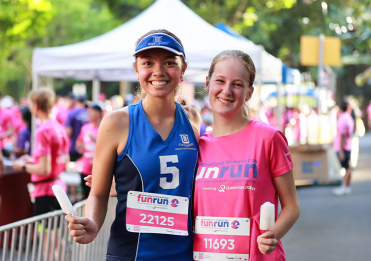Mrs Tara McLachlan, School Psychologist
‘To love ourselves is the beginning of a life-long romance’
—Oscar Wilde
The most important relationship you will have in your life is the one that you have with yourself, which is why it is the relationship that is most worthy of our time, generosity, and care (Gaston, 2020). However, many of us struggle with the idea of putting ourselves first and think that prioritising self-care means we are being selfish. Adolescent girls will not hesitate to stay up late supporting a friend, say ‘yes’ when they actually want to say ‘no’, and will keep quiet for fear of upsetting others. We need to remind girls that if they take care of themselves and prioritise their needs, they will be happier, healthier individuals, and they will be able to invest more in their relationships. The saying, ‘You can’t pour from an empty cup’ absolutely applies to self-care—you cannot give to others if you do not take care of yourself first and foremost.
Self-care is defined as any activity that enhances our emotional, physical, and mental wellbeing. At its most basic level, self-care is taking care of ourselves physically—having an early night, nourishing and moving our bodies, relaxing, having a warm bath, or giving ourselves a facial. However, it is also much more than these physical acts, and for adolescent girls, physical and emotional self-care are equally as important. Emotional self-care is being aware of our emotions and taking the necessary steps to honour and care for these feelings. This could include putting their own needs first, maintaining healthy boundaries, practicing self-compassion, asking for help, or simply spending time doing things they love.
Self-care and wellbeing are intrinsically connected. Wellbeing is the state of being comfortable, happy, healthy, and fulfilled, and it is nurtured in every moment through intentional acts of self-care (Gaston, 2020). At Girls Grammar we talk to the students about the ‘Five Foundations for Radiant Wellbeing’ to ensure that students are socially, emotionally, and physically at their best and ready to learn.
1. Cultivating rest and play
As defined by Dr Brene Brown in The Gifts of Imperfection (Brown, 2010), play is time spent engaging in activities that are purely for enjoyment rather than a serious or practical purpose. As humans, we have a biologically programmed need for play, however, somewhere in between childhood and adulthood, we stop playing. In today’s culture, where there is a tendency to base our worthiness on our level of productivity, spending time doing purposeless activities tends to be rare. Despite this, research continues to demonstrate that play is beneficial for people of all ages, adding joy to life, relieving stress, improving brain function, boosting energy and creativity, and connecting us to others. For adolescent girls, spending time actively engaged in play might involve activities such as painting, singing, dancing, doing puzzles, or playing board games.
Rest is considered equally as important as play, but the main barrier to being able to rest is that exhaustion tends to be considered a status symbol of hard work, and sleep is considered a luxury.
Rather than adopting this cultural mindset, we need to choose instead to rest and prioritise sleep. This doesn’t mean that we are lazy, weak, or unproductive; it means that we value our health and wellbeing, and we want to take care of ourselves. This is something that parents can also model and encourage for our girls.
2. Completing the stress cycle
The concept of completing our body’s stress cycle is based on the work of Dr Amelia and Dr Emily Nagoski in their ground-breaking book Burnout: The Secret to Unlocking the Stress Cycle (Nagoski & Nagoski, 2020). Their work explored the notion that in our day-to-day lives, there are ‘stressors’—threats or perceived threats that can be external or internal. There is also ‘stress’—the neurological and physiological shift that happens in our bodies when we encounter a stressor, often referred to as the ‘flight, fight, or freeze’ response. Our minds can manage stressors, and on a cognitive level we might know that we are safe, but our bodies continue to hold on to the stress until we are able to complete the stress cycle and experience a physiological shift.
There are seven evidence-based strategies for completing the stress cycle:
- Physical activity
- Breathing
- Positive social interaction
- Laughter
- Physical affection
- Crying
- Creative expression
3. Centring the self
Centring ourselves is a way to find peace, comfort, and calm within the chaos, stress, and busyness that might be surrounding us. It requires checking in with ourselves and making time to be still, quiet, and connect with our internal world. This concept is something that we teach our students to embrace with breathing, mindfulness, and journaling practices.
4. Compassion and kindness
We spend our lives pushing ourselves to do more, be better, work harder, and then we criticise ourselves when we fall short. Our inner critic pushes us to achieve, and we worry that without it, we will lose motivation and not do anything. The antidote to self-criticism and perfectionism is self-compassion, which involves paying attention to our needs and responding with kindness—whether it be in the way that we speak to ourselves or through our actions. According to world-leading self-compassion expert, Dr Kristin Neff (2011), there are three elements of self-compassion:
- Self-kindness: being kind to ourselves during times of suffering
- Common humanity: the recognition that suffering is a shared human experience
- Mindfulness: noticing feelings without judgement.
Self-compassion can be practiced using mantras, compassionate touch, or loving-kindness meditations.
5. Curiosity and gratitude
As outlined by Dr Julia Baird in her book Phosphorescence (Baird, 2020), we can benefit from cultivating the sensations of awe, wonder, and curiosity by slowing down, paying attention, spending time in nature, and seeking new experiences. Gratitude is a concept that everyone is familiar with because it is strongly and consistently associated with greater happiness and wellbeing. Being grateful does not mean that we ignore or erase the difficult things, but it does allow us to acknowledge the good in life and reframe our experiences. We can practice gratitude with journaling or gratitude meditations and mindfulness practices.
How do we make time for self-care in our busy lives I hear you ask? Self-care does not need to be something that we schedule and add to our never-ending to-do list. Sometimes it is about doing less instead of more. Self-care is always an option, and like anything in life the more we practice and attend to it, the more natural and effortless it becomes (Gaston, 2020).
Tips for making time for self-care:
- Decide to prioritise self-care—this may mean reallocating time, saying no to an invitation, setting boundaries, and giving yourself permission to relax or play
- Develop a plan—create self-care goals and plan the ways in which you might take care of yourself physically, emotionally, and mentally
- Start small—every little bit counts and small, incremental, everyday routines can lead to significant positive change over time
- Ask for help—we need the support of others to take care of ourselves.
References:
- Baird, J. (2020). Phosphorescence: On Awe, Wonder and Things That Sustain You When The World Goes Dark. HarperCollins Publishers.
- Brown, B. (2010). The Gifts of Imperfection: Let Go of Who You Think You’re Supposed to Be and Embrace Who You Are. Hazelden Publishing.
- Clear, J. (2018). Atomic Habits: An Easy & Proven Way to Build Good Habits & Break Bad Ones. Penguin Random House.
- Gaston, M. (2020). At Home Within: A Little Book of Self-Care Wisdom. Hardie Grant Books.
- Nagoski, E., & Nagoski, A. (2020). Burnout: The Secret to Unlocking the Stress Cycle. Ebury Publishing.
- Neff, K.D. (2011). Self-Compassion: The Proven Power of Being Kind to Yourself. William Morrow.







